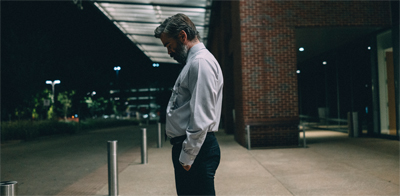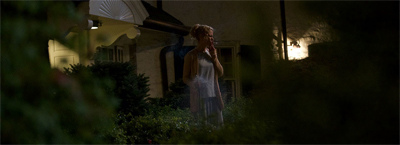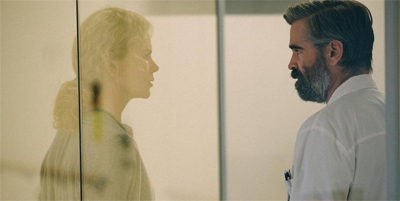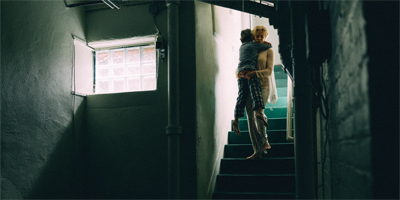The Killing of a Sacred Deer is cold, clinical and Kubrick. Perhaps too much so in places. It is also mesmerising and haunting.
“Do you understand?” Martin asks a confused Steven towards the climax. “It’s a metaphor. My example. It’s metaphorical.” As one might expect from director Yorgos Lanthimos, The Killing of a Sacred Deer is very much couched in symbolism and metaphor. As the title implies, a reference casually suggested by a minor character quite late in the film, The Killing of a Sacred Deer might be best understood as a modern update of Iphigenia in Aulis, the tragedy of the Greek general Agamemnon who was forced to sacrifice his daughter to a vengeful god.

The man upstairs.
However, that is an incomplete prism through which The Killing of a Sacred Deer might be understood. The tale of a patriarch faced with an impossible choice to protect his family from a sinister outside force, The Killing of a Sacred Deer is a study of masculinity and responsibility. The film is an interrogation of sex and power through a surreal lens, skewed through psychological horror and pitch black comedy. The Killing of a Sacred Deer is never entirely abstract, but it is very rarely literal. It exists in a surreal and uncomfortable space that enhances the audience’s unease.
The Killing of a Sacred Deer is an uncanny piece of cinema, an ethereal moral fable that lingers long after its resolution.

Putting the matter to bed.
It is hard to classify The Killing of a Sacred Deer in terms of genre. It is at once a surreal family drama and a tense psychological thriller, with a pitch black sense of humour. The film transitions through these genres with relative ease and fluidity, crossing over and back without any hesitation. The effect is disorienting, but deliberately so. Yorgos Lanthimos remains in complete control of the film throughout the runtime, with every shot feeling perfectly calculated and every frame meticulously constructed.
The Killing of a Sacred Deer is particularly unnerving because it seems to unfold in a hazy space between fantasy and reality. The central conceit of the story is fantastical, with heart surgeon Steven Murphy watching his family afflicted by a strange condition with no medical cause. Although there is no material evidence to support the claim, and though the mechanics of the situation are never explored, the film is quite clear that the strange young man named Martin is responsible for this chaos.

Surgical precision.
The Killing of a Sacred Deer accepts Martin’s influence without question or explanation. The film never elaborates upon the scope and nature of the affliction affecting that Murphy family. Martin lists three symptoms that will affect each member of the clan, but these are in no way intended as a diagnosis; they serve as both prove of Martin’s abilities and as a ticking clock against which Steven must race. Steven cannot count on science or medicine to save his children. Instead, Steven has to take responsibility for his actions.
There is an uncanniness to The Killing of a Sacred Deer, a sense of “off-ness” that extends beyond the basic plot summary. Characters do not talk like human beings, instead expressing themselves like robots that have heard second-hand accounts of how people might interact. At a black tie dinner function, asked how his children are, Steven explains, “Our daughter started menstruating last week.” There is a weird quality to the human interactions in The Killing of a Sacred Deer, as if contractions do not exist and grammar is always correct. Nobody finds this weird.

Even, Steven.
The cast acquit themselves very well. Colin Farrell seems perfectly in tune with the script, playing Steven as a very boring man who feels that he has very important ideas about how best to construct a watch strap. However, Barry Keoghan is perfectly cast as Martin, the mysterious young boy who sets the entire plot in motion. The Killing of a Sacred Deer is never entirely clear what exactly Martin is, and Keoghan pushes his performance towards the uncanny. It takes a lot of work for an actor to seem particularly uncanny in The Killing of a Sacred Deer, but Keoghan excels.
Virtually every important plot point in The Killing of a Sacred Deer is symbolic. Early in the film, after an awkward dinner party, Martin is confronted with a woman who finds his hands fascinating. His hands are clean and sterile. Given so much of The Killing of a Sacred Deer lies in the challenge of taking responsibility for something grotesque and monstrous, the choice of feature and the choice of compliment are thematically important.

Somebody needs to give Martin a good dressing down.
Even the sex in The Killing of a Sacred Deer is symbolic. Early in the film, Martin plays out a sexual fantasy with his wife Anna; he names a type of anesthetic and she lies still as if under its influence. Martin arranges her on the bed, like a prop. Later, his daughter emulates that same affect. Another sexual encounter later in the film is treated as similarly mechanical, as a clinical and sterile action. (At one point, Martin even discusses his own first sexual experience in mechanical terms.)
However, The Killing of a Sacred Deer juxtaposes this abstract and ethereal plotting with a decidedly concrete aesthetic. The Killing of a Sacred Deer does not unfold in some abstract realm. Mavropsaridis frequently frames shots so as to emphasise signage and to instill a sense of place in the film. Street signs and building fronts all confirm that The Killing of a Sacred Deer is set in Cincinnati. These inclusions are not accidental; the Christ Hospital is pretty much a co-star of the film.

Out in the weeds.
Similarly, director Yorgos Lanthimos and cinematographer Thimios Bakatakis make a point to film The Killing of a Sacred Deer in a very straightforward and very grounded way. Everything in the film is perfectly lit, often in shades of light cream or white. Even the play room underneath the Murphy residence has that same sterile quality to it. The Killing of a Sacred Deer is shot on steadicam, meaning that every shot feels clinical and calculated. The camera pushes, zooms and pans, but does so in a very methodical manner.
There is something very dispassionate in the way that The Killing of the Sacred Deer approaches its characters. The film has a decidedly Kubrickian quality, with a lot of emphasis on clean glass and smooth white surfaces, all lit in such a way as to seem clinical and detached. The camera frequently pushes in on its characters, but never enthusiastically. Even before the characters are paralysed, The Killing of a Sacred Deer understands that it has no need to chase them. The camera lurks more than it peers, follows more than it pursues.

Reflecting on it all.
The film invites these comparisons. Like The Shining, the true horror movie in Kubrick’s oeuvre, The Killing of a Sacred Deer is about the failure of a man to protect his family in a chaotic world. The soundtrack even samples from composer György Ligeti, who informed a lot of Kubrick’s work and whose compositions provided a lot of the haunted sense of place that made The Shining such an uncanny and uncomfortable horror film.
Of course, The Killing of a Sacred Deer is not purely a horror film, just as it is not purely a parable. The film is also bleakly funny at times, wry in its sense of humour. When it becomes clear that Martin might have to sacrifice one of his family to settle this blood debt, the rest of the family begin praying for their lives; Anna is a lot more responsive to her husband and a lot more rational in her arguments, young Bob is a lot more eager to do his chores and follow instructions, young Kim is noble and virtuous in the hope of proving herself worthy of survival.

Carry on.
Then again, perhaps these are all layers of horror placed on top of one another, designed to enhance the sense of the uncanny and the uncomfortable. There are moments when The Killing of a Sacred Deer veers too far into the abstract, almost becoming self-parody as Anna mocks Steven’s efforts to impose a sense of the mundane upon their ridiculous and horrifying situation. Of course, The Killing of a Sacred Deer is smart enough to accept this self-parody as self-criticism, a wry acknowledgement of its own archness.
Still, there are moments when The Killing of a Sacred Deer is too arch and too reflexive, when it turns a little too sharply from philosophical abstraction into emotional drama. These moments are jarring and distracting, but they are also relatively rare. For the most part, The Killing of a Sacred Deer is a carefully constructed and meticulously calibrated piece of work, one finely tuned so that it might hit all the right notes at all the right times. Its weirdness is part of the film’s harmony, a tone that holds everything together.

Shirt, why not?
The Killing of a Sacred Deer is a striking piece of work, one crafted with considerable skill and executed with incredible grace.
Filed under: Non-Review Reviews | Tagged: barry keoghan, colin farrell, film, non-review review, review, the killing of a sacred deer, Yorgos Mavropsaridis |




















Looking forward to it as I loved Lobster and Dogtooth…
“There is an uncanniness to The Killing of a Sacred Deer, a sense of “off-ness” that extends beyond the basic plot summary. Characters do not talk like human beings, instead expressing themselves like robots that have heard second-hand accounts of how people might interact.” – I felt this in his other films too. What is fascinating is that in certain artificially constructed ambients people really behave so…
Hope you enjoy it, even if “enjoy” is the wrong word. I actually wrote a companion piece for the film in the magazine CinÉireann, if you want to dig into it a bit. It’s available online for free.
I’d love too, but it seems I cannot open it on my Android tablet… (the wi-fi on my PC doesn’t work now).
If this is a study of masculinity and responsibility, what are we to make of Steven’s failure to consider himself as a potential sacrifice? Jacqueline @moonmind.blog
I’d argue that’s a further abdication of his responsibility, and also a reflection of the way that strains of toxic masculinity seems to expect patriarchs to put themselves separate (and above) their families.
What a well written review.
‘The camera frequently pushes in on its characters, but never enthusiastically. Even before the characters are paralysed, The Killing of a Sacred Deer understands that it has no need to chase them. The camera lurks more than it peers, follows more than it pursues.’
Maybe that’s why in all of his movies I feel uncomfortable, like I’m not supposed to be there…that I’m a lurker.
I just noticed one mistake I would like to kindly point out: Yorgos Mavropsaridis is the editor of the film, Yorgos Lanthimos is the director. Don’t worry Greek names are weird. 😛
Ha! Good spot! Corrected. Cheers.